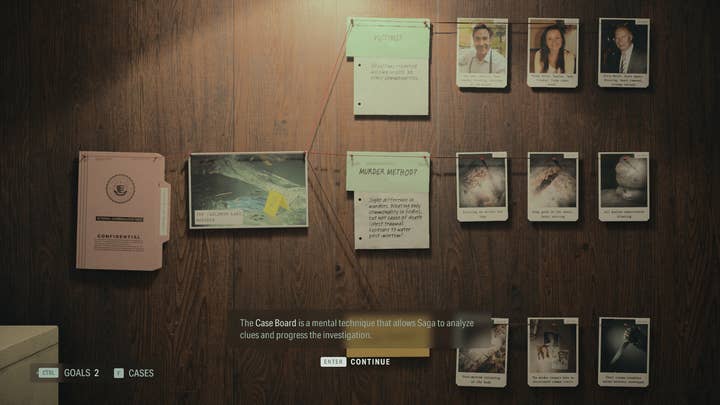Final 12 months’s Alan Wake 2 launched to essential acclaim, profitable awards reminiscent of the sport Award for finest narrative on the 2023 Sport Awards, and this 12 months’s BAFTA Sport Award for Inventive Achievement.
At GDC 2024, principal narrative designer Molly Maloney and affiliate recreation director Simon Wasselin talked about a couple of narrative design parts that assist make the sport such a cohesive expertise, specializing in gameplay actions gamers can usually take whether or not they’re controlling Alan and Saga.
In an trade the place the excellence between author and narrative designer is usually unclear or the phrases are even used interchangeably, Wasselin and Maloney’s central message is that this Narrative design is about figuring out and designing options and instruments that help a cohesive story. If the narrative design workforce is correctly empowered, it’s doable to create deep funding purely by means of alternatives for expression.
The central query Wasselin and Maloney requested themselves when starting work on Alan Wake 2 was methods to construct funding in gamers; in any case, the story itself was strictly linear and did not give gamers the chance to affect it by means of instruments reminiscent of branching dialogue, both.

“It isn’t a very scorching take that that linear, single-player story video games have much less company than a branching recreation or a sandbox recreation that continuously throws these selection moments on the participant,” Maloney mentioned. “So it is really extra necessary to take benefit of and even create new participant expression alternatives in linear video games.”
Alan Wake 2 has three fastened recreation pillars, which means parts the sport positively wanted to have: fight, alternatives to play with mild and darkness and the very aptly named ‘make it scary’ pillar. Past that, every bit of content material must help storytelling, so whereas narrative and fight are sometimes seen as separate points of video games, for instance, in Alan Wake 2 even fight actively tells the story or aids it.
“Why make the participant watch one thing after they can do it? If doable, we should not depend on narrative bookending to inform the majority of the narrative,” Wasselin mentioned. “Keep away from exposition cutscenes, and tie narrative to interplay each time doable. Even a small interplay is healthier than none, and when that is not doable discover tips to make the participant nonetheless work for it.”
This narrative design philosophy underpins all of Alan Wake 2, and manner of considering Wasselin took from his work as at Quantic Dream. Whereas that studio is thought for making video games that department very strongly, the principle trick of making gamers carry out actions themselves each time doable works largely for each recreation, as Wasselin defined.
“It was most necessary for us to combine the participant fantasy instantly into the mechanic,” he mentioned. “You have to consider your gameplay verbs to just remember to have sufficient to inform the story you wish to inform.”
Which means that Treatment created gameplay that, whereas maybe not correct to what it’s prefer to be a detective – or a author, in Alan’s case – would nonetheless fulfil the participant’s fantasy of it. Saga’s thoughts place and Alan’s author’s room do that in a number of methods.
“These areas comprise what we name modules; the case board for Saga and plot board for Alan are such modules. In addition they embody parts extra historically present in menus, reminiscent of maps and collectibles,” Wasselin mentioned. “They must share sufficient widespread parts that the participant would not must discover ways to play the sport twice. Some parts are current in each areas, whereas some are one another’s counterparts.”
“We constructed a complete house for what may have been a menu, nevertheless it’s necessary that gamers can affect the house and see their work mirrored again at them”
Molly Maloney, Treatment
The time period for these similarities in design is commonality. Utilizing commonality, Treatment may educate the participant a mechanic as soon as and then use it in each elements of the stor; one other instance of that is the objects within the secure rooms, which work the identical manner for each characters.
Moreover, the workforce used a precept from UX design referred to as skeuomorphism to cut back the psychological load on the participant by having some parts perform and really feel the way in which they might in the actual world. The vinyl participant performs music from the sport, you’ll find maps you collected in-game caught to surfaces within the thoughts place, and you’ll be able to exit by means of the door.
“We’re conscious we constructed a complete house for what may have been a menu,” Maloney mentioned, “However for participant funding it is necessary that gamers can work together with and affect the house and see their work mirrored again at them.”

For Saga’s gameplay, Maloney highlighted three parts that every one affect one another and feed into the case board within the thoughts place.
“We needed to provide gamers the fantasy of being an FBI agent with an emphasis on exploration and puzzle fixing,” she mentioned. “Principally, we dissected the fantasy of what an FBI agent is right into a collection of actions that our gamers may really do: gameplay conversations, exploration and profiling.”
The case board, impressed by HBO present True Detective, initially featured free placement of clues and gated progress till gamers discovered a selected reply, however this led to excessive participant frustration. Treatment shifted to a board that featured extra questions with simpler solutions, resulting in extra dopamine hits with gamers, and lastly scrapped free clue placement to keep away from litter.
“As a substitute of an energetic element, it turned reactive to what gamers have been doing in-game and helped them perceive the story higher,” Maloney mentioned. “Briefly, it turned a journal.”
Maloney as soon as once more pressured the truth that gamers can interact with clues themselves as a substitute of simply gathering them in a menu, making one thing passive energetic, makes the essential distinction.
“Why make gamers watch after they can do? We should not depend on narrative bookending to inform the story”
Simon Wasselin, Treatment
“Low expression puzzle mechanic versus actually excessive expression journal mechanic,” she mentioned. “What’s higher, a journal you’ll be able to write, or a journal you’ll be able to learn? By largely letting go of the puzzle element and the free clue placement, we made the board one of the best model of what the sport wanted it to be, as a substitute of a mediocre model of one thing we could not let go of. A easy motion remains to be higher than no motion, and letting the participant place it helps with info retention, too.”
In the meantime, giving gamers the chance to overlook non-crucial clues heightens their motivation to search out every part and additional reveals that they have an effect on the board.
The profiling mechanic is what Maloney referred to as “a fancier model of common gameplay conversations”. Primarily, Treatment needed to discover a technique to let gamers speak to NPCs once more with out the necessity to backtrack to get the data they wanted.
“We’ve quite a bit of exposition on this recreation and we did not need the participant locked into these more and more repetitive gameplay conversations,” Maloney defined. “We wanted extra different methods to relay exposition; additionally, it is enjoyable to grill and interrogate individuals.”
Within the completed model, Saga sits at her profiling desk and receives one thing akin to unsettling visions during which NPCs reply necessary questions. The funding building right here is within the aptitude these profiling conversations have, due to eerie writing and calmly spooky sound and visible design.
“On this case, a change in presentation can create the wanted affect, and for my part, this can be a very good instance of the way it takes a village, when design, artwork audio and writing all work collectively you may make one thing distinctive and cool, even with the issues you have already got,” Maloney mentioned.

In the meantime, Alan is metaphorically in two locations directly – he’s each the author and the star of his personal story. Once more, Treatment broke down the fantasy of being a author, ending up with the weather of discovering inspiration, mapping out the story through the use of that inspiration, and exploring the outcomes. All these parts wanted to be expressed in his gameplay parts of the sport.
“Discovering inspiration was fairly tough to show right into a gameplay mechanic,” Wasselin mentioned. “We tried issues like actively gathering symbols on the earth to simply passively exploring an space. We additionally thought of utilizing Saga’s mechanic of discovering clues on the earth. This was nonetheless too advanced, and we wanted to go away room for different gameplay mechanics just like the puzzles utilizing mild.”
Wasselin and his workforce settled on the echo scenes, that are cutscenes that you just set off within the in-game atmosphere. They symbolize Alan issues from a selected angle to search out inspiration. As a result of they happen within the atmosphere, there’s the danger that the participant may merely transfer on with out watching the scene, so a powerful audiovisual presentation was key.
Gamers haven’t got quite a bit of company over echo scenes – they basically simply set off and watch a scene – however once more the trick is to have gamers do one thing, quite than having them passively watch. The undeniable fact that gamers additionally want to unravel the echo scene puzzle, though it is comparatively easy in nature, causes friction by not immediately giving them entry to what they want, and rewards them for the trouble. Wasselin cautioned that the steadiness between rewarding and irritating varieties of friction could be tough to get proper, however pressured the payoff is value it.
The gameplay mechanic for mapping out the story began as one thing fairly comparable as Saga’s case board however was rejected by testers. Some similarities nonetheless exist; Alan has a board that he sticks plot parts to, for instance, represented by single sentences or phrases. By combining these plot snippets with footage, gamers can change a scene, transporting Alan to a unique in-game atmosphere. These scene adjustments are spectacular and, as Wasselin admitted, costly to supply.
“By limiting the place and what you can affect, we may make it work with out overblowing our finances,” he mentioned. “Scenes turned particular places that you can affect, selection could be represented by plot parts that you can affect by means of echo scenes. We wanted to bend our personal guidelines – wanting the plot board to reflect the case board so badly made it tough to design.”
“A easy motion remains to be higher than no motion, and letting the participant place it helps with info retention, too”
Molly Maloney, Treatment
Identical to with Saga’s case board, the workforce determined to forego some of the realism they have been so fond of as a way to design one thing that might be extra satisfying to make use of. Within the last model, gamers can discover a number of phrases that change particular places, and even when they do not discover the fitting reply by deduction, they’ll strive all doable scenes out and discover the fitting one to progress by trial and error – one thing Wasselin mentioned is by the way similar to the artistic writing course of.
“Improper solutions could be enjoyable so long as you retain the improper reply attention-grabbing sufficient that there’s nonetheless some worth for the participant,” Wasselin mentioned. “Letting the participant experiment is an effective way to provide company, and permitting the participant to search out the fitting reply by themselves provides them a way of possession over the answer. It additionally creates extra alternatives for visuals, sources, enemies, or narrative content material, if the finances permits.”
Whereas there are extra instruments that Wasselin and Maloney could not cowl as half of their speak, their major recommendation was to let the participant take actions each time doable and to not be afraid to allow them to work for the answer. Good presentation can elevate even easy mechanics, and if gamers work for info and are offered with methods to lighten their psychological load, they’ll retain that info extra simply.
“Your recreation could have totally different wants than our recreation had,” Maloney concluded. “However for those who perceive the story you’re telling you can find the issues that give you the results you want. It may be very straightforward to throw your palms up and say ‘it’s what it’s, the story cannot change’, however whereas we won’t at all times guarantee participant company, possession and funding could be constructed by means of expression.”
